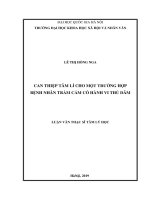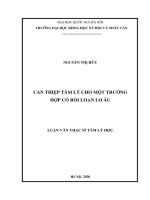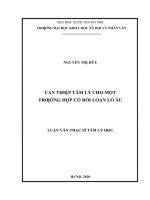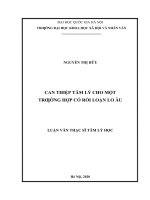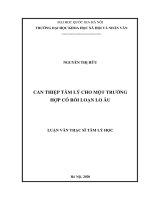NHẬN DIỆN, LƯỢNG GIÁ VÀ CAN THIỆP TÂM LÝ CHO TRẺ EM GẶP RỐI LOẠN CHUYÊN BIỆT HỌC TẬP TRONG BỐI CẢNH HỌC ĐƯỜNG
Bạn đang xem bản rút gọn của tài liệu. Xem và tải ngay bản đầy đủ của tài liệu tại đây (3.29 MB, 25 trang )
<span class="text_page_counter">Trang 1</span><div class="page_container" data-page="1">
<b>NHẬN DIỆN, LƯỢNG GIÁ VÀ CAN THIỆP </b>
<b>TÂM LÝ CHO TRẺ EM GẶP RỐI LOẠN CHUYÊN BIỆT HỌC TẬP TRONG BỐI CẢNH HỌC ĐƯỜNG</b>
IDENTIFICATION, ASSESSMENT AND INTERVENTION FOR CHILDREN WITH SPECIFIC LEARNING
DISORDERS IN SCHOOL CONTEXT
<b><small>• KHOA TÂM LÝ HỌC – ĐẠI HỌC KHOA HỌC XÃ HỘI VÀ NHÂN VĂN, ĐHQG HCM• ĐẠI HỌC LOUVAIN, UCLOUVAIN, BỈ</small></b>
<b><small>• ĐẠI HỌC LIÈGE, ULIÈGE, BỈ</small></b>
<b><small>• VIỆN NGHIÊN CỨU VÀ GIẢNG DẠY ĐẠI HỌC BỈ, ARES</small></b>
</div><span class="text_page_counter">Trang 2</span><div class="page_container" data-page="2"><b>MỤC LỤCTRỤC 1</b>
<b>PHÁT TRIỂN ĐỌC, VIẾT, TÍNH TỐN, </b>
<b>NGƠN NGỮ NĨI VÀ CÁC RỐI LOẠN CHUYÊN BIỆT HỌC TẬP</b>
1. XÂY DỰNG, TRIỂN KHAI, KẾT QUẢ DỰ ÁN HỢP TÁC ĐÀO TẠO VIỆT-BỈ VỀ RỐI LOẠN CHUYÊN BIỆT HỌC TẬP TẠI VIỆT NAM TRONG 5 NĂM (2016-2021)
<i>Tập thể GV và Chuyên gia</i>
2. COMPLEXITÉ ET ENJEUX DE L’IDENTIFICATION DES ENFANTS À HAUT POTENTIEL
<i>Jacques Grégoire</i>
3. MỘT SỐ VẤN ĐỀ LIÊN QUAN ĐẾN VIỆC XÁC ĐỊNH TRẺ TIỀM NĂNG CAO
<i>Jacques Grégoire</i>
NUMÉRIQUE DES ENFANTS ÂGÉS DE 0 À 6 ANS
<i>Lê Thị Mai Liên</i>
7. SONG NGỮ – ĐA NGÔN NGỮ VÀ CÁC CA LÂM SÀNG
<i>Anne-Sophie RENAULT TRAN</i>
</div><span class="text_page_counter">Trang 3</span><div class="page_container" data-page="3">9. MỐI QUAN HỆ GIỮA ĐỌC VÀ VIẾT TIẾNG VIỆT Ở HỌC SINH ĐỌC KÉM BẬC TIỂU HỌC
<i>Huỳnh Mai Trang</i>
10. BIỆN PHÁP GIÁO VIÊN VẬN DỤNG ĐỂ HỖ TRỢ HỌC SINH TIỂU HỌC GẶP KHÓ KHĂN HỌC TẬP
<i>Phan Thị Thanh Hương</i>
12. TỔNG QUAN CÓ HỆ THỐNG VỀ SỰ HIỆU QUẢ CỦA CAN THIỆP VỚI TRỊ CHƠI MÁY TÍNH CHO RỐI LOẠN TÍNH TỐN
<i>Vũ Bích Phượng, Lê Ngọc Bảo Trâm</i>
13. THỰC NGHIỆM DẠY HỌC ĐỌC HIỂU CHO HỌC SINH KHUYẾT TẬT TRÍ TUỆ HỌC HÒA NHẬP CẤP TIỂU HỌC
<i>Phạm Hà Thương</i>
14. PHẢN HỒI CỦA CỰU HỌC VIÊN VỀ KHÓA ĐÀO TẠO RỐI LOẠN CHUYÊN BIỆT HỌC TẬP: TỪ ĐÀO TẠO
15. MỐI LIÊN HỆ GIỮA LỊNG TỰ TRỌNG VÀ TRÍ NHỚ BẰNG LỜI CỦA SINH VIÊN TRƯỜNG ĐẠI HỌC KHOA HỌC XÃ HỘI & NHÂN VĂN - ĐHQG TP. HỒ CHÍ MINH
<i>Nguyễn Mỹ Duyên, Nguyễn Minh Hồng Nguyên, Đặng Thị Thanh Hảo, Nguyễn Thị Vân</i>
260
</div><span class="text_page_counter">Trang 4</span><div class="page_container" data-page="4">16. THE RELATIONSHIPS BETWEEN FREQUENT SOCIAL MEDIA USAGE, CREATIVE BEHAVIOR AND CREATIVE ACHIEVEMENT IN UNIVERSITY STUDENTS
<i>Vu Bich Phuong, Nguyen Quoc Viet</i>
17. ẢNH HƯỞNG CỦA TIẾNG ỒN TRẮNG ĐẾN SỰ CHÚ Ý VÀ TRÍ NHỚ LÀM VIỆC CỦA HỌC SINH TIỂU HỌC CÓ ADHD
<i>Triệu Minh Tài, Nguyễn Minh Quang, Lê Ngọc Bảo Trâm</i>
18. TƯƠNG QUAN GIỮA KHOẢNG NHỚ XUÔI, KHOẢNG NHỚ NGƯỢC VÀ CÁC BIẾN NHÂN KHẨU HỌC Ở SINH VIÊN ĐẠI HỌC QUỐC GIA THÀNH PHỐ HỒ CHÍ MINH
<i>Nhan Thị Lạc An, Nguyễn Thị Minh Duyên, Lê Huỳnh Đức, Nguyễn Tấn Phát</i>
19. TƯƠNG QUAN GIỮA IQ, TRÍ NHỚ CĨ LỜI VÀ CÁC CHIẾN LƯỢC MÃ HÓA TRONG TRẮC NGHIỆM
20. NỖI SỢ COVID-19 VÀ MỐI LIÊN HỆ VỚI STRESS TRONG HỌC TẬP CỦA SINH VIÊN ĐẠI HỌC ĐỒNG NAI
<i>Nguyễn Thị Bích Tuyền, Nguyễn Thanh Trúc</i>
21. CLASSROOM PEER STATUS AS A MEDIATOR OF THE RELATIONSHIP BETWEEN BEHAVIOR PROBLEMS AND ACADEMIC OUTCOMES AMONG PRIMARY STUDENTS
<i>Nguyen Minh Khue, Nguyen Hong An, Vo Tan Phuong Hong, Tran Thi Truc Phuong, Nguyen Minh Thanh</i>
353
</div><span class="text_page_counter">Trang 5</span><div class="page_container" data-page="5">22. THE ROLE OF EMOTION REGULATION IN BEHAVIORAL PROBLEMS AND ACADEMIC PERFOR-MANCE AMONG VIETNAMESE ADOLESCENTS
<i>Le Hoang The Huy, Jacques Grégoire</i>
23. BƯỚC ĐẦU PHÁC HỌA HÌNH DUNG XÃ HỘI CỦA NGƯỜI TRƯỞNG THÀNH VỀ TRẺ VỊ THÀNH NIÊN “ỔN VỀ MẶT CẢM XÚC” TẠI MỘT SỐ ĐỊA PHƯƠNG Ở VIỆT NAM
<i>Le Hoang The Huy</i>
24. BƯỚC ĐẦU KHÁM PHÁ VỀ HỆ GIÁ TRỊ NHÂN VĂN Ở TRẺ EM VIỆT NAM: KHẢO SÁT TẠI THÀNH PHỐ HỒ CHÍ MINH
<i>Bùi Thị Huệ, Lê Hồng Thế Huy</i>
25. SỰ PHÁT TRIỂN HÌNH ẢNH BẢN THÂN CỦA VỊ THÀNH NIÊN SỐNG TRONG TRUNG TÂM BẢO TRỢ XÃ HỘI - NGHIÊN CỨU TRƯỜNG HỢP
<i>Nguyễn Hồng Xuân Nguyên, Kiều Thị Thanh Trà</i>
26. A SYSTEMATIC REVIEW OF THE PSYCHOMETRIC PROPERTIES OF THE NOMOPHOBIA MEASUREMENTS
<i>Nguyen Tuan Vinh, Nguyen Bao Uyen, Nguyen Phuong Hong Ngoc</i>
27. TỔNG QUAN CÁC NGHIÊN CỨU VỀ MỐI QUAN HỆ GIỮA GIẤC NGỦ VỚI SỨC KHỎE VÀ CÁC CHỨC NĂNG NHẬN THỨC CỦA TRẺ VỊ THÀNH NIÊN
<i>Hồ Thu Hà, Nguyễn Phương Hồng Ngọc, Nguyễn Minh Hằng, Dương Thị Hoài</i>
28. TÁC ĐỘNG CỦA KỸ NĂNG LÀM CHA MẸ TÍCH CỰC LÊN SỰ THAY ĐỔI HÀNH VI Ở TRẺ 2-6 TUỔI
<i>Nguyễn Thị Diệu Anh, Đỗ Ngọc Khanh</i>
465
</div><span class="text_page_counter">Trang 6</span><div class="page_container" data-page="6">29. LẠM DỤNG BẰNG LỜI NĨI TRONG GIA ĐÌNH VÀ RỐI LOẠN CẢM XÚC Ở NẠN NHÂN: TỔNG QUAN NGHIÊN CỨU
<i>Lê Thị Huyền, Nguyễn Đức Tài, Nguyễn Thị Thảo Linh, Hoàng Thị Hệ, Nguyễn Phương Hồng Ngọc</i>
30. TÁC ĐỘNG CỦA CÁC CHƯƠNG TRÌNH HỌC TẬP CẢM XÚC VÀ XÃ HỘI (SEL) ĐẾN KHẢ NĂNG ĐIỀU TIẾT CẢM XÚC CỦA TRẺ EM TRONG HỌC ĐƯỜNG
<i>Lê Ngọc Bảo Trâm</i> TRONG BỐI CẢNH HỌC ĐƯỜNG
<i>Lê Nguyễn Anh Như, Ngô Xuân Điệp</i>
34. ABILITY PRAISE VERSUS EFFORT PRAISE ON SELF-EFFICACY OF UNIVERSITY STUDENTS
<i>Vu Bich Phuong, Quach Diem Phuc, Nguyen Thi Thach Thao, Doan Quoc Thuong</i>
35. LIFE SATISFACTION OF CHILDREN AGED FROM 8 TO 12 YEARS AND RELATED ASPECTS
<i>Ngo Thi Hoang Giang, Truong Thi Khanh Ha</i>
594
</div><span class="text_page_counter">Trang 7</span><div class="page_container" data-page="7">36. BIỂU HIỆN STRESS CỦA GIÁO VIÊN CAN THIỆP TRẺ TỰ KỶ TẠI THÀNH PHỐ BIÊN HỊA, TỈNH ĐỒNG NAI
<i>Huỳnh Thị Bích Thuộc, Nguyễn Thị Bích Tuyền, Nguyễn </i>
37. YOUTH MENTAL HEALTH FIRST AID (YMHFA): A LITERATURE REVIEW AND PUBLIC MENTAL HEALTH RECOMMENDATION FOR VIETNAMESE STUDENTS
<i>Le Dao Anh Khuong</i>
38. MỐI TƯƠNG QUAN GIỮA TÍNH CÁCH VÀ PHƯƠNG THỨC HỌC TẬP
<i>Nguyễn Hoàng Như Thảo, Võ Thị Minh Thư, Nguyễn Minh Quang, Hồ Hương Lan, Đinh Hồng Nhi, Vương Quốc Thuần, Nguyễn Thị Vân</i>
39. CHƯƠNG TRÌNH CB-ART HỖ TRỢ TÂM LÝ CHO TRẺ HẬU ĐẠI DỊCH COVID-19: CAN THIỆP THEO SALUTOGENESIS
<i>Huỳnh Minh Thư, Trì Thị Minh Thúy</i>
40. VAI TRÒ CỦA GIÁO DỤC CẢM XÚC - XÃ HỘI TRONG HỖ TRỢ TÂM LÝ HỌC ĐƯỜNG CHO TRẺ EM GẶP RỐI LOẠN HỌC TẬP
<i>Phan Thị Cẩm Giang</i>
41. HOẠT ĐỘNG SÀNG LỌC TRONG CÔNG TÁC CHĂM SÓC SỨC KHỎE TÂM THẦN CHO HỌC SINH MỘT SỐ TRƯỜNG THPT TẠI THÀNH PHỐ HỒ CHÍ MINH
<i>Hứa Vĩnh An, Phạm Hải Lâm</i>
42. SỬ DỤNG PHƯƠNG PHÁP TEACCH TRONG GIÁO DỤC HÀNH VI XÃ HỘI HÓA CHO TRẺ RỐI LOẠN PHỔ TỰ KỶ
<i>Nguyễn Thị Thoa</i>
704
</div><span class="text_page_counter">Trang 8</span><div class="page_container" data-page="8">43. GIÁO DỤC KĨ NĂNG THỰC HIỆN NỘI QUY LỚP HỌC CHO TRẺ RỐI LOẠN PHỔ TỰ KỶ CHUẨN BỊ VÀO LỚP 1 - KẾT QUẢ NGHIÊN CỨU TRƯỜNG HỢP
<i>Mai Thị Phương, Trần Thu Giang</i>
44. ĐỐI DIỆN VỚI VẤN ĐỀ TỰ TỬ CỦA HỌC SINH - SINH VIÊN QUA GĨC NHÌN NGƯỜI LÀM TÂM LÝ TRONG BỐI CẢNH HỌC ĐƯỜNG
<i>Nguyễn Lê Minh Trang, Phạm Hải Lâm</i>
45. GIỚI THIỆU MƠ HÌNH CAN THIỆP VỀ ĐỊNH HƯỚNG NGHỀ NGHIỆP CHO HỌC SINH - SINH VIÊN VIỆT NAM (HBCD)
<i>Nguyễn Duy Vũ, Phạm Hải Lâm</i>
46. BUILDING CHILDREN’S MALADAPTIVE BEHAVIOR MANAGEMENT PROGRAM FOR GRANDPARENTS IN VIET NAM – PRACTICAL BASIS
<i>Tran Thi Hai Yen</i>
47. THỰC TRẠNG HOẠT ĐỘNG SỬ DỤNG CÁC CÔNG CỤ ĐÁNH GIÁ TÂM LÝ TRONG TRƯỜNG HỌC
<i>Nguyễn Thị Hường, Nguyễn Phương Hồng Ngọc, Trần Thị Mai Phương</i>
48. BẰNG CHỨNG KHOA HỌC VỀ HIỆU QUẢ CỦA MƠ HÌNH CAN THIỆP SỚM DENVER TRONG CAN THIỆP CHO TRẺ RỐI LOẠN PHỔ TỰ KỶ
<i>Đào Nguyên Tú</i>
49. ỨNG DỤNG GIAO TIẾP TĂNG CƯỜNG VÀ THAY THẾ TRONG CAN THIỆP CHO TRẺ CÓ RỐI LOẠN PHỔ TỰ KỶ – NGHIÊN CỨU TRÊN CASE LÂM SÀNG
<i>Huỳnh Thị Minh Tâm</i>
50. THỰC TRẠNG SỬ DỤNG THIẾT BỊ ĐIỆN TỬ CỦA TRẺ CÓ RỐI LOẠN PHỔ TỰ KỶ Ở THÀNH PHỐ HỒ CHÍ MINH
<i>Phan Thiệu Xuân Giang, Đoàn Thế Dũng</i>
834
</div><span class="text_page_counter">Trang 9</span><div class="page_container" data-page="9"><b>A SYSTEMATIC REVIEW OF THE PSYCHOMETRIC PROPERTIES OF THE NOMOPHOBIA</b>
<i>Nguyen Tuan Vinh*<small>1</small>, Nguyen Bao Uyen<small>2</small>, Nguyen Phuong Hong Ngoc<small>3</small></i>
<i>This paper has generated a review of research concerning the psychometric properties of nomophobia measurements. The results concluded that there are several scales used for nomophobia such as Nomophobia Questionnaire (NMP-Q), Questionnaire to Assess Nomophobia (QANP), Nomophobia Scale (NSPS), and the new Interactive Electronic Nomophobia Test (IENT). These scales have high overall reliability and satisfactory internal consistency. The most widely used measurement instrument is the Nomophobia Questionnaire (NMP-Q). The psychometric properties of NMP-Q were examined in different countries to determine the prevalence of nomophobia in individuals. The IENT is assessed as a good assessment instrument of nomophobia for children and adolescents. The other scales are best used with adults. These results contribute to an exploration of the psychometrics of the measurement instruments of nomophobia and their appropriate use among different participants and contexts. </i>
<i><b>Keywords: psychometrics, measurement, nomophobia </b></i>
<b>TỔNG QUAN HỆ THỐNG VỀ ĐẶC ĐIỂM TÂM TRẮC CỦA CÁC CÔNG CỤ ĐÁNH GIÁ CHỨNG SỢ </b>
<b>THIẾU ĐIỆN THOẠI DI ĐỘNG</b>
<i><b>Tóm tắt </b></i>
<i>Bài nghiên cứu này là một bài nghiên cứu tổng quan đặc điểm tâm trắc các dụng cụ đo lường về chứng sợ thiếu điện thoại. Kết quả nghiên cứu cho thấy </i>
<small>1 University of Education, Hue University.* Corresponding email: </small>
<small>2 The Congregation of the Lovers of the Holy Cross of Hue.</small>
<small>3 University of Education, Vietnam National University, Hanoi.</small>
</div><span class="text_page_counter">Trang 10</span><div class="page_container" data-page="10"><i>có các thang đo được dùng để đánh giá chứng sợ thiếu điện thoại như sau: thang đo Nomophobia Questionnaire (NMP-Q), thang đo Questionnaire to Assess Nomophobia (QANP), thang đo No SmartPhone Scale (NSPS) và thang đo Interactive Electronic Nomophobia Test (IENT). Tất cả các thang đo này đều có độ tin cậy và giá trị nội hàm cao, đặc biệt thang đo Nomophobia Questionnaire (NMP-Q) được thích ứng và sử dụng nhiều nơi trên thế giới. IENT là thang đo chứng sợ thiếu điện thoại phù hợp đối với trẻ vị thành niên, trong khi các thang đo NMP-Q, NSPS, QANP được sử dụng cho người lớn. Kết quả nghiên cứu này đóng góp vào việc xác định dụng cụ đánh giá chứng sợ thiếu điện thoại đạt tiêu chuẩn khoa học, có độ tin cậy cao và phù hợp với từng đối tượng khác nhau.</i>
<i><b>Từ khoá: đặc điểm tâm trắc, công cụ đánh giá, chứng sợ thiếu điện thoại di động</b></i>
<b>I. INTRODUCTION</b>
Today, people are constantly engaged with digital technology. For them, constantly using a smartphone is indispensable communication. Not surprisingly, many Vietnamese people have also become devotees of the smartphone. From 2005 to 2010, smartphone subscriptions in Vietnam increased by 72.4% with 175.3 mobile phone subscriptions for every 100 people. This increase is much higher than other developing Southeast Asian countries such as Singapore (7%) and Thailand (17%) (So, 2012). Such an initiative has advantages and challenges. Indeed, smartphones provide many opportunities by combining the services of the Internet and a mobile phone. As such, smartphones encourage people to have virtual communication and have access to extensive resources of information, both locally and internationally. Regrettably, the use of smartphones can also be problematic. It has made users depend too much on it (Karsenti, & Fievez, 2013). The most challenging issue regarding smartphones’ use is nomophobia or smartphone dependence.
The word ‘nomophobia’ originates from “non-mobile” and “phobia”, referring to the discomfort which is generated by not having access to mobile devices or being unable to use them when required (Ahmed et al., 2019; Farooqui et al., 2018; King et al., 2013; Santos et al., 2017). Nomophobia often generates fear and anxiety (Aker et al., 2017) which not
</div><span class="text_page_counter">Trang 11</span><div class="page_container" data-page="11">only impedes communication with others (Ozdemir et al., 2018) but also the capacity to access information (Santos et al., 2017) from the Internet or smartphone (Aguilera-Manrique, 2018). Not surprisingly, this isolation promotes debilitating loneliness (Gezgin et al., 2018) which contributes to students’ poor academic achievement (Louragli et al., 2018).
It is helpful to distinguish between nomophobia and smartphone dependency. Nomophobia is an irrational fear concerning the inability to access a smartphone or internet connection. In contrast, smartphone addiction or dependence concerns the excessive use of smartphones (Yildiz Durak, 2019) that may interfere with the user’s daily life (Lee et al., 2014). This study explored nomophobia only.
A number of measurement instruments evaluate nomophobia especially those from the youth population. These include: Nomophobia Questionnaire/NMP-Q (Yildirim & Correia, 2015), Questionnaire to Assess Nomophobia/ QANP (Olivencia-Carrión et al., 2018), Nomophobia Scale/NSPS (Gurbuz & Ozkan, 2019) and the new Interactive Electronic Nomophobia Test/ IENT, using (NMP-Q)’s model as a theoretical framework (Kazem et al., 2021).
A systematic analysis of the psychometrics of measurement instruments of nomophobia has been scarce. Thus, this study aims to give an overview of the psychometrics of these instruments of nomophobia. In particular, it will examine the validity and reliability of these measurement instruments used for nomophobia evaluation. Such information will be helpful for researchers whose studies concern nomophobia and its consequences. This study will address the following questions:
1. What are the measurement instruments used for nomophobia? 2. How are the psychometric properties of the measurement
instruments evaluated?
3. What are the strengths and limitations of these scales?
<b>II. METHOD</b>
This study examines the available literature focused on psychometric properties of the nomophobia measurement instruments. The study
</div><span class="text_page_counter">Trang 12</span><div class="page_container" data-page="12">adopted the Preferred Reporting Items for Systematic Reviews (PRISMA) (Moher et al., 2009) guidelines. The benefits of PRISMA are to help authors depict a flow diagram of information through different phases of a systematic review and to reach sources used to identify the eligibility of studies for the present study.
<b>2.1. Search strategy</b>
The keywords “nomophobia”, “no mobile phobia”, “no smartphone phobia” and “measurement of nomophobia” were used to search in Scopus databases and the Web of Science. The results were found either in the form of abstract or full-text.
<b>2.2. Inclusion criteria</b>
Following the PRISMA’s guidelines, the main objectives of this study were to identify the flow of information through the different phases of a systematic review, in which the study describes the number of records identified, included and excluded, and the reasons for exclusions. In this study, 10 articles were identified in the Scopus database, and 50 other articles were found on the Web of Science. The initial records were 60
<i>articles (N = 60). Then 31 articles were deleted since they did not meet the inclusion criteria. Inclusion criteria were these: (1) nomophobia is </i>
the central focus of the study, (2) study is in Journal Citation Reports, (3) study is an article, (4) and study conforms to APA standards including at least introduction, methods, results, discussion and conclusion. The 29 remaining articles were examined for eligibility with the full text. The exclusion was applied to the articles focused on measurement instruments for smartphone dependence because smartphone dependence was not the main focus of this study. Articles without validation on nomophobia measurement were also excluded. Then the final records identified were 21
<i>(N = 21) (Figure 1).</i>
</div><span class="text_page_counter">Trang 13</span><div class="page_container" data-page="13"><b>Figure 1. Flow diagram of PRISMA’s guidelines for this systematic reviewIII. RESULTS</b>
The articles examined in this present study were written in English, meeting the standard of a scientific article and APA standards, including abstract, literature review, research objectives, research methods, research results, discussion and conclusion. The references included in these articles are clearly organized according to the APA standards. These articles were published from 2012 to 2021.
<b>3.1. Sample size</b>
The present study analyzed in detail 21 articles on the psychometric properties of measurement instruments for nomophobia. Of the 21 articles, 17 studies were on the Nomophobia Questionnaire/NMP-Q
<i>(N=17) including two original studies (N=2) and 15 other studies </i>
<i>validating the scale across countries (USA, N=1; Turkey, N=4; Spain, </i>
<i>N=3; Iran, N=2; Kuwait, N=1; Italy, N=1; Lebanon, N=1; Portugal, N=1; </i>
<i>Indonesia, N=1); One study of Questionnaire to Assess Nomophobia/QANP was analyzed (Spain, N=1); Two studies on Nomophobia Scale/NSPS were explored (N=2); the new Interactive Electronic Nomophobia Test/IENT was examined (N=1). These results indicated that there are </i>
four scales used to evaluate the prevalence of nomophobia: Nomophobia Questionnaire (NMP-Q) is the most widely used and validated scale across
</div>
